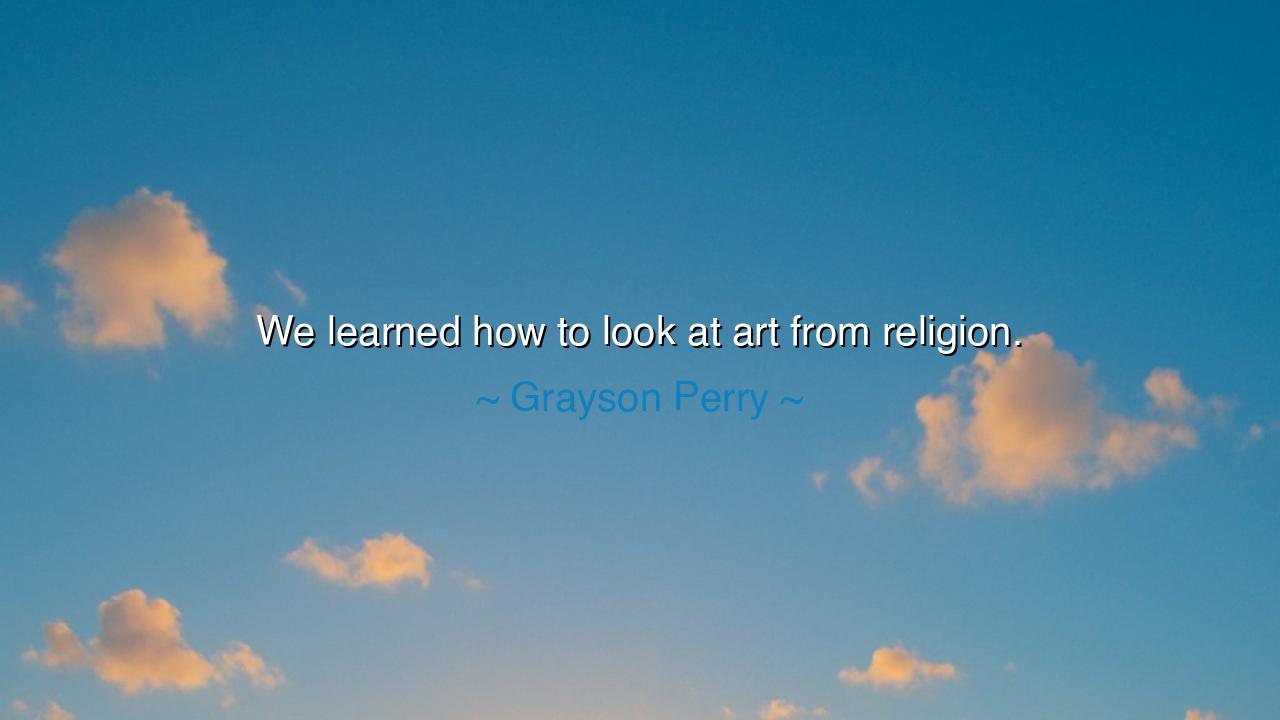
We learned how to look at art from religion.






"We learned how to look at art from religion." These words by Grayson Perry speak to a profound truth about the connection between art and religion throughout history. Perry suggests that our understanding of art—its symbolism, its purpose, and its emotional impact—has been deeply influenced by religious traditions and practices. From the ancient Egyptians to the medieval Christians, religious rituals, artifacts, and iconography have shaped how we engage with and interpret art. The relationship between religion and art is not just one of influence; it is foundational, for religion has been the source of many of the most powerful and transformative works of art across the ages.
In the ancient world, the most significant forms of art were often created for religious purposes. Temples, statues, and paintings were not merely artistic endeavors but were expressions of the divine. The Greeks, for example, constructed grand temples dedicated to their gods, like the Parthenon in Athens, where the very architecture and decoration served to honor the divine order. In these temples, the gods were not just worshipped but were visually represented through intricate sculptures and paintings. These works of art were meant to convey a deep connection between the physical world and the spiritual—to help humans transcend the mundane and glimpse the divine. The act of viewing such art was itself a spiritual experience, and the very purpose of these pieces was to make the unseen visible.
Throughout history, religion and art continued to intersect. The Christian tradition, for example, gave rise to a wealth of artistic masterpieces. The Renaissance, a period marked by an explosion of artistic and intellectual achievement, was deeply influenced by Christian values and the belief in a divine order. Artists like Michelangelo, Raphael, and Leonardo da Vinci painted scenes from the Bible, with Jesus Christ, the Virgin Mary, and the saints being central to their works. For these artists, creating religious art was not simply an aesthetic practice but a spiritual calling—a way to engage with the divine and communicate spiritual truths to the masses. Just as religion teaches its followers to look at the world through the lens of faith, so too did art invite people to see the sacred in everyday life, and to experience the divine through beauty.
But Perry’s statement speaks not only to the role of religion in producing art but also to the ways in which religion has shaped our understanding of what art is and how it should be interpreted. Religion teaches its followers to engage with symbols, to seek deeper meaning beneath the surface, and to understand the spiritual significance of everyday objects. Similarly, art invites its viewers to see beyond the material world, to interpret symbols, and to connect with something larger than themselves. In this way, the teachings of religion have shaped our approach to art—teaching us that there is meaning in the unseen and the intangible, that beauty can be a path to the divine, and that the physical world is often a reflection of something greater.
Consider the example of the Sistine Chapel by Michelangelo, one of the greatest religious artworks ever created. The frescoes on the ceiling, depicting scenes from the Bible, invite the viewer to contemplate the creation of humanity, the fall of man, and the relationship between God and man. These images are not merely artistic expressions—they are deeply tied to the spiritual significance of the stories they depict. The viewer is not only meant to appreciate the artistry of Michelangelo’s brushstrokes but also to be moved by the sacred themes they explore. The work transcends mere aesthetics; it is an act of worship, of communion with the divine, through art.
The lesson in Perry’s words is clear: art and religion are inseparable in the story of human culture. Whether it is the religious sculptures of the ancient Egyptians, the paintings of the Renaissance, or the iconography of Buddhism, art has long been used as a tool to explore the divine and communicate the sacred. As we engage with art in our own lives, we must recognize the profound connections between the artistic and the spiritual. Just as religion teaches us to see the world through a sacred lens, so too should we learn to approach art as a medium that can elevate the soul, offering us glimpses into the mysteries of the universe and our place within it.
In our own lives, we should approach art not just as something to admire but as a way to engage with the divine and the mysterious. Whether we are viewing a painting, listening to music, or creating something ourselves, we should remember that art has the power to reveal the sacred in ways that words alone cannot. We should also be mindful of the spiritual significance that art can carry—whether in the church, the temple, or in the quiet of our homes. Let us embrace art as a means of engaging with meaning that goes beyond the physical world, a tool for reflection, growth, and spiritual awakening.






AAdministratorAdministrator
Welcome, honored guests. Please leave a comment, we will respond soon